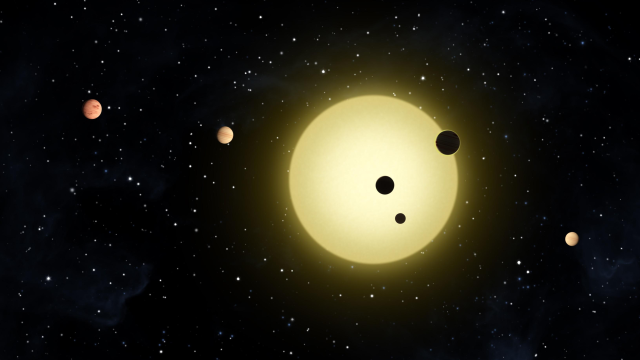Living on Earth, without a single other habitable world in eyeshot, can sometimes feel pretty lonely. But our isolation may be the cosmic exception. In fact, it’s possible that throughout the galaxy, life-bearing worlds usually come in pairs.
It sounds pretty far-fetched — we haven’t found a single other habitable planet, and now we’re talking two? — but an intriguing new paper by astrophysicist Jason Steffen of the University of Nevada and Gongjie Li of Harvard’s Center for Astrophysics suggests that systems with two Goldilocks planets might, in fact, be the best places to hunt for life. The reason? Microorganisms could hitchhike between the two worlds, increasing their chances of surviving a planet-sterilizing event.
Over the last five years, NASA’s planet-hunting Kepler mission has discovered thousands of worlds, many of them rocky and Earth-sized. Extrapolating from Kepler’s small galactic census, astronomers now believe there may be a hundred billion planets Milky Way; roughly one for each star. Up to a billion of those planets could be Earth-sized worlds sitting in the not-too-hot, not-too-cold Goldilocks zone of a Sun-like star. As exoplanet researcher Lisa Kaltenegger put it when discussing the possibility of life beyond Earth, “the numbers are, fortunately, very much in our favour”.
Of course, finding a rocky, Earth-sized world isn’t the same as finding life. To do the latter, we’ll need to get a much better look at these distant planets — and that’s something the next generation of space-based telescopes will enable. But which planets to check out first?
Perhaps we should be pointing our scopes toward stars with planets very close together. Kepler has already found systems with pairs of planets on orbits that differ by less than ten per cent — several times closer than the distance between Earth and Mars. As Steffen and Li demonstrate using numerical models, if such a celestial pairing occurred in the right place, the two worlds could help one another sustain life.
The reason has to do with lithopanspermia — a (theoretical) process whereby microbial life travels between planets via comets, asteroids, and ejected particles. Some scientists believe life could have arrived on Earth by this very process, or that escaped chunks of our planet might have infected the outer solar system with terrestrial germs long ago.
But while life would have to be incredibly resilient to survive the trip from Earth to Europa — a journey that would likely take millions of years — two planets very close together might exchange organisms easily and often. The energy of impact needed to get rocks from one planet to another would be relatively low, and the duration of the cold, radiation-filled journey through space fairly short. What’s more, because of the way impact debris travels, Steffen and Li show that material ejected from one planet could hit a neighbouring world in several locations at once.
Meaning: if a life-ending asteroid struck a luckless planet in a multi-habitable system, chunks of rock may go whizzing off into space, only to shower a nearby world with alien bacteria. As Steffen put it in a press conference today, this sort of cross-fertilization means that “the burden of surviving catastrophic events is shared between multiple planets in the same system”.
“Multihabitable systems could have a microbial family tree with roots and branches simultaneously on two different planets,” Steffen said. “Systems like those that we investigated, and moon systems orbiting a habitable-zone giant planet, are among the few scenarios where life — intelligent life in particular — could exist in two places at the same time and in the same system.”
It’s a pretty intriguing idea, but it’s completely speculative at this point. “Kepler doesn’t have many habitable-zone planet candidates (the habitable zone was near the edge of its sensitivity) and only a small fraction of them would have the particular orbital configurations that we are discussing,” Steffan told Gizmodo in an email. But, he continued: “Even if only 0.1% of the systems have multiple planets in their habitable zones, then that is still a hundred million potential systems.”
Now, Steffan and his colleagues are gearing up to study data collected by NASA’s forthcoming Transit Exoplanet Survey Satellite (TESS) mission, which will scour nearby star systems for Earth-like planets. Soon, we may have a good idea of just how common these multi-planet systems are in our cosmic backyard. Who knows, maybe we’ll get lucky and find two interstellar vacation homes, not so far away. Somebody better start building a generation ship.
[Read a pre-print of the scientific paper on arXiv]
Top image: Artist’s concept of a multi-planetary system, via Wikimedia
